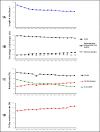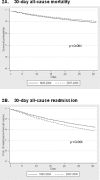Trends in length of stay and short-term outcomes among Medicare patients hospitalized for heart failure, 1993-2006
- PMID: 20516414
- PMCID: PMC3020983
- DOI: 10.1001/jama.2010.748
Trends in length of stay and short-term outcomes among Medicare patients hospitalized for heart failure, 1993-2006
Abstract
Context: Whether decreases in the length of stay during the past decade for patients with heart failure (HF) may be associated with changes in outcomes is unknown.
Objective: To describe the temporal changes in length of stay, discharge disposition, and short-term outcomes among older patients hospitalized for HF.
Design, setting, and participants: An observational study of 6,955,461 Medicare fee-for-service hospitalizations for HF between 1993 and 2006, with a 30-day follow-up.
Main outcome measures: Length of hospital stay, in-patient and 30-day mortality, and 30-day readmission rates.
Results: Between 1993 and 2006, mean length of stay decreased from 8.81 days (95% confidence interval [CI], 8.79-8.83 days) to 6.33 days (95% CI, 6.32-6.34 days). In-hospital mortality decreased from 8.5% (95% CI, 8.4%-8.6%) in 1993 to 4.3% (95% CI, 4.2%-4.4%) in 2006, whereas 30-day mortality decreased from 12.8% (95% CI, 12.8%-12.9%) to 10.7% (95% CI, 10.7%-10.8%). Discharges to home or under home care service decreased from 74.0% to 66.9% and discharges to skilled nursing facilities increased from 13.0% to 19.9%. Thirty-day readmission rates increased from 17.2% (95% CI, 17.1%-17.3%) to 20.1% (95% CI, 20.0%-20.2%; all P < .001). Consistent with the unadjusted analyses, the 2005-2006 risk-adjusted 30-day mortality risk ratio was 0.92 (95% CI, 0.91-0.93) compared with 1993-1994, and the 30-day readmission risk ratio was 1.11 (95% CI, 1.10-1.11).
Conclusion: For patients admitted with HF during the past 14 years, reductions in length of stay and in-hospital mortality, less marked reductions in 30-day mortality, and changes in discharge disposition accompanied by increases in 30-day readmission rates were observed.
Figures


References
-
- Haldeman GA, Croft JB, Giles WH, Rashidee A. Hospitalization of patients with heart failure: National Hospital Discharge Survey, 1985 to 1995. Am Heart J. 1999;137(2):352–360. - PubMed
-
- Lee WC, Chavez YE, Baker T, Luce BR. Economic burden of heart failure: a summary of recent literature. Heart Lung. 2004;33(6):362–371. - PubMed
-
- Liao L, Allen LA, Whellan DJ. Economic burden of heart failure in the elderly. Pharmacoeconomics. 2008;26(6):447–462. - PubMed
-
- Centers for Medicare & Medicaid Services Medicare ranking for all short-stay hospitals by discharges fiscal year 2006 versus 2005. [Accessed August 19, 2009]. http://www.cms.hhs.gov/MedicareFeeforSvcPartsAB/Downloads/SSDischarges05....
-
- Braunstein JB, Anderson GF, Gerstenblith G, et al. Noncardiac comorbidity increases preventable hospitalizations and mortality among Medicare beneficiaries with chronic heart failure. J Am Coll Cardiol. 2003;42(7):1226–1233. - PubMed
Publication types
MeSH terms
Grants and funding
LinkOut - more resources
Full Text Sources
Medical
Research Materials
Miscellaneous

